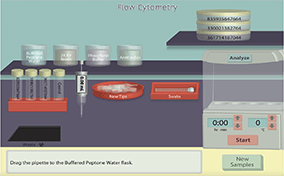What is a flow cytometer?
A flow cytometer is a digital tool used to determine both the number of and the properties of particles in a fluid. Cells in the fluid are first labeled with a fluorescent marker and then are passed single file by a given point where a laser or multiple lasers excite the cells, which causes an emission of light of varying wavelengths. This emission is captured and analyzed on an output display. Some flow cytometers make use of impedance-based analysis systems that take the place of the laser or lasers as an excitation device.
What are some benefits of using a flow cytometer?
Flow cytometers can count, isolate, and/or label thousands of cells per second. This process can be completed in real time and does not require overnight culturing of samples. This enables sample analysis completion times of minutes instead of hours. Flow cytometers can also be used to quickly separate specific cells from a mixture of various cell types.
How is a flow cytometer used?
Flow cytometry is used in a variety of applications, including environmental and product testing for contaminants, genetic testing, identification of blood disorders, cancer testing, and the testing of immunological diseases and treatments, such as transplant rejection, response to growth factors, remission of disease, and immunotherapy.
How are flow cytometry results interpreted?
The output display of a typical flow cytometer presents a logarithmic graph of side scatter intensity versus fluorescence intensity. A predefined boxed region specific to the microbe being tested for is generated in the graph for the product contaminant being investigated, such as Salmonella or E. coli. The output display also presents a readout of the total number of contaminants (typically cells) on screen, as well as the percentage of contaminants falling within the boxed area. A total count of 49 or fewer cells/0.25 mL sample falling within the boxed area indicates no significant microbe contamination present within the product sample. A total count of 50 or more cells/0.25 mL sample indicates product contamination by microbes. Counts over 50 may be the result of other residual products being present in the sample if the majority of the points fall outside of the designated box on the output display and may not necessarily be indicative of contaminants being present in the sample.
 Product contamination by harmful microbes is a serious threat to a variety of industries, including food, cosmetics, and a host of others. Fast, easy tests that accurately measure the counts of microbes present in a sample are highly desired. Flow cytometry is one tool that provides results of the microbial concentration in a product in minutes instead of having to wait overnight for culture growth. Are you ready to go with the flow and count microbes in a product sample?
Product contamination by harmful microbes is a serious threat to a variety of industries, including food, cosmetics, and a host of others. Fast, easy tests that accurately measure the counts of microbes present in a sample are highly desired. Flow cytometry is one tool that provides results of the microbial concentration in a product in minutes instead of having to wait overnight for culture growth. Are you ready to go with the flow and count microbes in a product sample?


